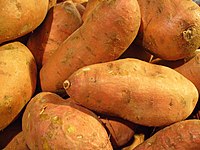
Photo from wikipedia
The functional components of leaves and stalks from 14 sweet potato cultivars were investigated by determining lutein, β-carotene, chlorophyll, tannin and phenolic acid contents. It was found that the contents… Click to show full abstract
The functional components of leaves and stalks from 14 sweet potato cultivars were investigated by determining lutein, β-carotene, chlorophyll, tannin and phenolic acid contents. It was found that the contents of the functional components in different cultivars differ significantly (p<0.05). Lutein, β-carotene and total chlorophyll contents were high in leaves and ranged from 19.01–28.85, 35.21–52.01 and 440.9–712.2 mg/100 g, respectively. The tannin and total phenolic acid contents of sweet potato leaves ranged from 2,280–4,460 and 2,640.2–4,200.9 mg/100 g, respectively. Significant correlations have been observed among cultivar, lutein, β-carotene, chlorophyll, and other antioxidants. The leaves of Healthymi cultivar contained the highest level of lutein, β-carotene and total chlorophyll, and Geonpungmi cultivar contained the highest level of the other antioxidant, among the all cultivars examined. Sweet potato leaves and stalks contain abundant functional components that make them potentially useful as fresh vegetables or processed foods.
Journal Title: Food Science and Biotechnology
Year Published: 2017
Link to full text (if available)
Share on Social Media: Sign Up to like & get
recommendations!